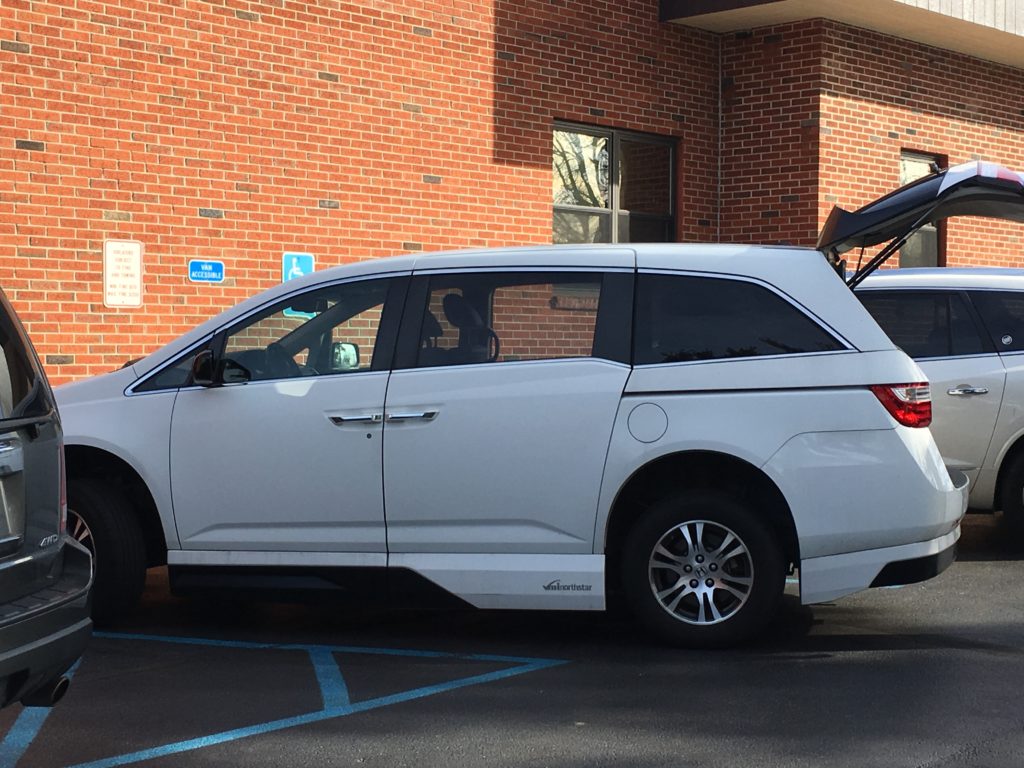What you need to know about buying a wheelchair accessible van
Are you at the stage in which lifting your child into and out of a car seat is becoming difficult? Are you exhausted after folding and lifting that bulky wheelchair in and out of the trunk during every outing? If so, it might be time to consider a wheelchair-accessible vehicle.
I was there, just like you. I lifted our son into and out of a Honda Pilot until he was 8 years old. I loaded his KidKart, Convaid Cruiser and even his gait trainer into the trunk on a regular basis. But he was getting heavier, his equipment was getting bigger, and my 5’0″ frame was struggling. It was time for us to find a wheelchair accessible vehicle.
We decided to go to our local Abilities Expo to compare accessible vans and SUVs. The van felt most spacious so we felt it was the best option for us. We did not already own a minivan so it made the most sense to find an already “converted” van. Since the state we lived in also did not have any benefits for vehicle modifications, buying a van on our own and then converting it also didn’t make much sense.
You should know that vans are not the only accessible vehicles out there. But, this post is only about vans because that’s what I have experience with! The options can be overwhelming, so being armed with the basics will give you a good start.

How does a minivan become wheelchair accessible?
You first need to know that wheelchair accessible minivans are not built with a ramp from the factory. A regular van must be converted to accomodate a ramp and remove the 2nd row seating to allow the wheelchair. The two major manufacturers that perform these conversions are Vantage Mobility (people call them VMI) and BraunAbility. Both of these companies can both convert the Honda Odyssey, Toyota Sienna, Dodge Caravan, and Chrysler Pacifica.
I encourage you to browse their websites (links provided above) to learn the details of what each can company can offer with respect to rear-entry vs side-entry, manual vs automatic and fold-out vs in-floor options. The options will vary depending on the manufacturer (VMI or Braun) and the vehicle make (i.e. Honda) and the costs can range from $15000 to $30,000 MSRP (Yes, that’s in addition to the cost of the vehicle!). The cost of the conversion (not the entire cost of the vehicle) is tax deductible which may help you out a little bit.
You should also know that a converted minivan cannot have the all-wheel drive feature. It also sits lower than many vehicles. If you have a steep driveway make sure you can easily drive the van in and out before you buy!
Where do you find accessible vans?
It is rare for a regular dealer such as Toyota to stock converted vehicles. You will need to find a mobility dealer who sells vehicles that have already been converted. The easiest way to find one is to go on the VMI or BraunAbility website and go to “locate a dealer” which will show you nearby dealers. If you click on the links above it will take you there directly!
These mobility dealers will have both brand new and used vehicles that have already been converted. If you are in the market for a brand new vehicle, you also have the option of purchasing through a regular dealer such as Toyota and then taking it to a mobility dealer to have the van converted. A dealer such as Toyota will not coordinate this for you. Nonetheless, it could be a better avenue for you if you prefer to choose the exact color, options, etc as compared to choosing from what the mobility dealer has in stock.
I urge you to visit a local mobility dealer, or a few if possible, to familiarize yourself with what is out there. You can also check out a nearby Abilities Expo, where you can see a variety of vehicles in one place. But first, I’ll give you the basics so your head doesn’t spin too fast when you do this for the first time.
Type of Entry: Is Rear-entry or Side-Entry best for you?
I suggest that you think about whether you prefer the ramp to come about of the back of the van (rear-entry) or the side of the van (side-entry is always on the right side for safety). Both have advantages and disadvantages you should consider.
Rear-entry
Rear-entry is less costly and allows you to park in any parking spot. You will not have to find a van-accessible parking spot to deploy the ramp! In fact, you may even get away with parking in a non-handicap space.
If you don’t know the difference between a van-accessible handicap space and a regular handicap space, keep reading. The van accessible handicap space is the handicap space with the painted stripes to the right of it. That striped space is where a side-entry ramp is deployed!! Most people don’t realize this spot is gold for those with side-entry ramps because the van-accessible spaces are quite limited. You can now see why rear-entry has an advantage over side-entry if you live somewhere where parking is limited.
What is the downside with a rear-entry ramp? You will have to deploy the ramp in traffic, for instance, in a busy grocery store parking lot. You also won’t have a lot of space to store cargo because the trunk space is essentially eliminated. Passenger seats are also limited. Although there can be seats next to the wheelchair-usre, I hear they are small and not super-comfy. The biggest deal breaker for us was having to unload all of our cargo (and you know how much stuff our kids require!) to take oru son out of the car at a rest stop during trips. For that reason alone, we opted for side-entry.

Side-entry
Side-entry conversions cost more and require that van-accessible handicap space I mentioned. It is annoying if you go to a doctor’s appointment alone with your child and can’t find an empty space. You can’t exactly drop your child at the entrance to the building and leave him alone while you go park!! We live in the suburbs and it really hasn’t been too much of a problem for us so far. During city trips it is more difficult and deserves some consideration.
What are the advantages to having a side-entry ramp that could outweigh the parking space issue? The bench seat in the back can seat 2-3 passengers which is a plus if you have additional children. You can also change your child on the bench seat if needed. A mobile changing table! Honestly, this has been huge for us for the past few years. But, our son is getting taller so I’m not sure how long we will have this luxury.
Another advantage is that you don’t need to unload your whole trunk to get your child out! So, can do a full Target run with your child and make aas many stops as you like before going home.
You will need to think about your own lifestyle, your budget, and availability of vehicles in your area to decide which type of entry will work best for you.
Automatic vs manual
This is fairly self-explanatory. An automatic ramp deploys with the push of a button and the manual ramp requires you to unfold or pull the ramp out yourself. I’m not too familar with the different manual ramps so I can’t give you much info on how easy or difficult it is. But, you should know that all automatic ramps have a back-up manual mechanism in case the ramp malfunctions (which does occasionally happen).
Fold-out vs In-floor:
A fold-out ramp folds up inside the vehicle when not in use and simply folds out when you deploy it. This means you cannot exit from the right rear door without deploying the ramp. This would be something to consider if you have other passengers who are not wheelchair users that would need to exit the vehicle on the curbside (i.e. kids during school drop-off). Another downside is that you always see the ramp in the vehicle if this is something that bothers you. The advantage is that it is less likely that debris such as leaves or grass impede the ramp mechanism as compared to in-floor ramp.
Here ‘s a video of a side-entry fold-out ramp so you can see for yourself.
The in-floor ramp is out of sight when not in use and only visible when you deploy it. More importantly, it is not blocking the rear right door so non-wheelchair users can exit the vehicle without deploying the ramp. Since the ramp is in the floor and not in the way, caregivers can be on either side of your child when needed. This is been helpful to us when our son has seizures, for instance. The open space available also allows me to turn the wheelchair sideways and change our son the bench seat in the back of the van. You should know that if debris or small items become stuck on/in the ramp, ramp malfunctions can happen. It has happened to us, but I am not certain if it was related to the conversion brand or the fact that it is an in-floor ramp.
Our experience
The Honda Odyssey with VMI side-entry, in-floor ramp is the only vehicle we have owned so far. I must tell you that our ramp has malfunctioned a few times due to debris stuck in the ramp. We’ve also had rust accumulation on the undersurface of the van twice, which apparently is common with VMI conversions. The company is now using a new material on the undersurface so perhaps that will prevent this from happening.
I also noticed is that our VMI conversion van is very loud inside as compared to a few BraunAbility conversion rentals we recently drove. Of course, I can’t be certain whether this is related to the conversion manufacturer, the make of the van, or combination. I am simply telling you my experience.
In summary, buying a wheelchair van is no joke in terms of the size of purchase. It’s helpful if you have some time to browse around so you can make the best choice for you, your child, and your family.
